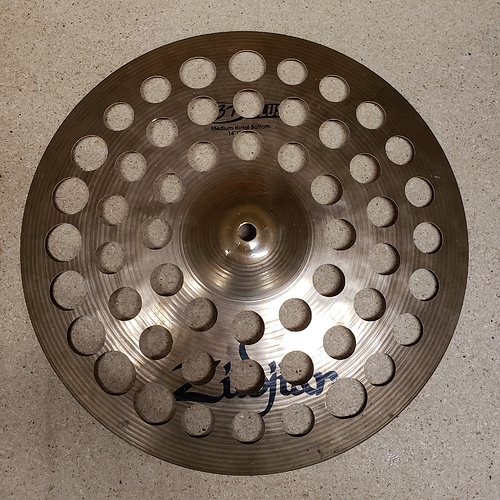If it’s in a drill press, he doesn’t need to use the pilot hole. He can just plunge the entire hole at once.
Well, perhaps not. 
“Usually” the deformation ends up on the removed piece. (it will look like a pringles potato chip)
And it is brass, so any deformation can be adjusted easily with a soft mallet, and way easier to fix than any mishap caused by milling…(lost steps cutting through the cymbal…). Bad retract…
And here is the result:
I’ll call it a success. The inner two rings of holes came out great! However, outer ring seemed to rotate slightly at one point. Had to run another pass on a few with slightly up-sized holes…
The process I ended up using: zero the Z axis for each ring of holes (3 total) and I ran a pocket process that was 4-5mm deep. The entire process ended up being more time consuming than I wouldv’e liked, but it was a fun little exercise nonetheless. That #278Z bit doesn’t mess around! Cut like butter!
If I would do it again…
-I should’ve added a “brim” to the brace. Think that would’ve prevented my headaches with row three.
-I wish there was a better way to integrate my STL of the cymbal into the toolpaths for CC pro. The process I used pretty much didn’t use it. Having the programming to account for the non-planar surface of the pocketing operation would’ve saved a lot of time and made the project much more feasible. Could just be ignorance on my end, though…
Thanks again for the help, y’all!
P.S. @Julien The feedrate for the #278 bit in the CC library was 54ipm. Doesn’t seem like it is taking into account that fact that the tool has only one flute (going by the math you posted, anyway). I ended up manually setting it to 18ipm.
Awesome ! Glad it turned out ok on first try.
Gotta love single flute coated endmills for metal
Yeah it’s not really meant for special cases like this where one would want to do local pocketing ops mapped to a curved surface. I think it targets the sweet spot where it can do 3D roughing/finishing on an arbitrary surface, since this covers the majority of usecases for most users, while not introducing the complexity of having to manage (and implement) tens of parameters like Fusion does (which does give optimal flexibility, at the cost of learning how to set them all).
I’ll have a look a that.
Nice Job,
Congrat’s!
Most importantly…does it have the sound you were looking for?
Just as a follow-up: I checked and you may have picked the settings from the wrong material category? the only material where the recommended feedrate for 278Z is 55ipm are polycarbonate and acrylic (which makes sense plastics do need a much higher feedrate to get good cuts), while for aluminium the recommended feedrate for the Shapeoko is 36ipm (and 10ipm for the Nomad). Well anyway it’s still double the chipload I mentioned, but they also recommend a shallow depth per pass of 0.015" so I’m not surprised, the 278Z can take that chipload easily in that scenario.
This topic was automatically closed 30 days after the last reply. New replies are no longer allowed.
